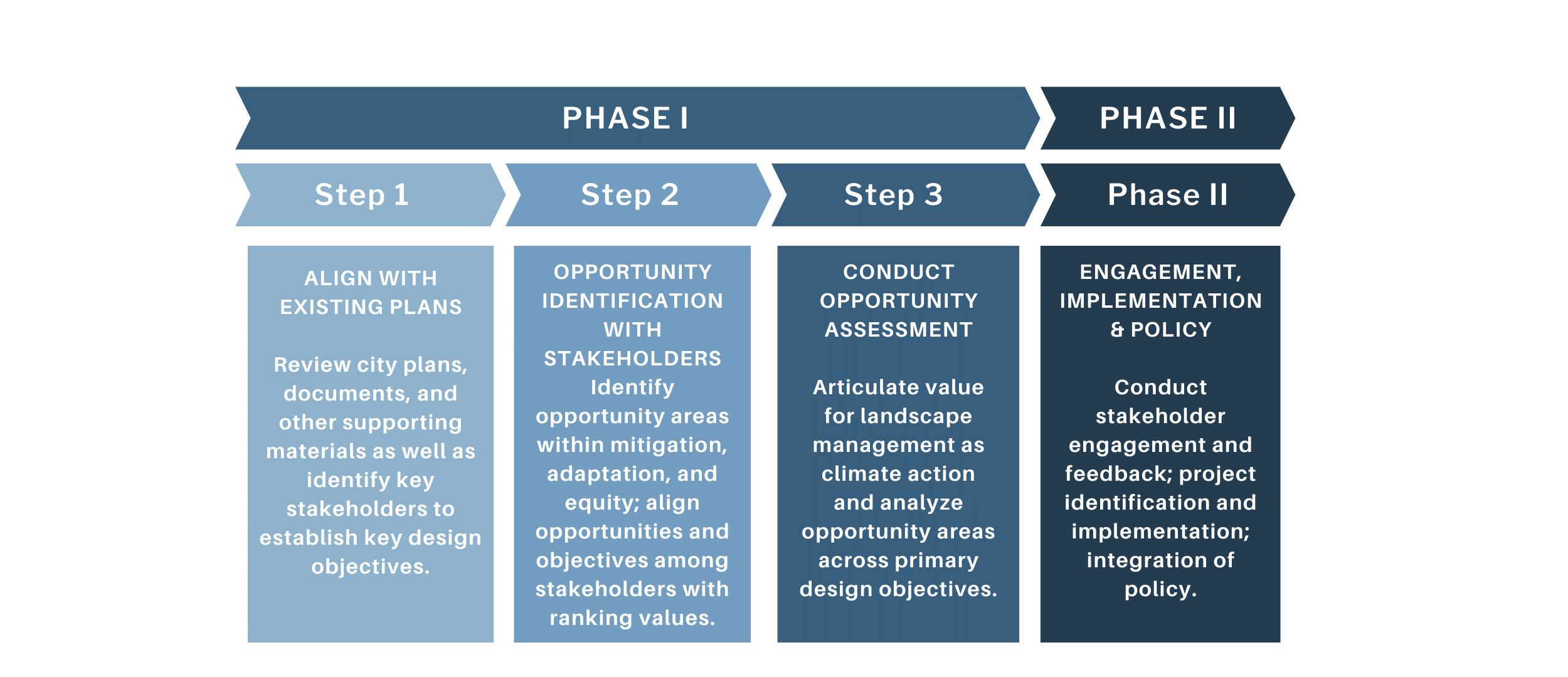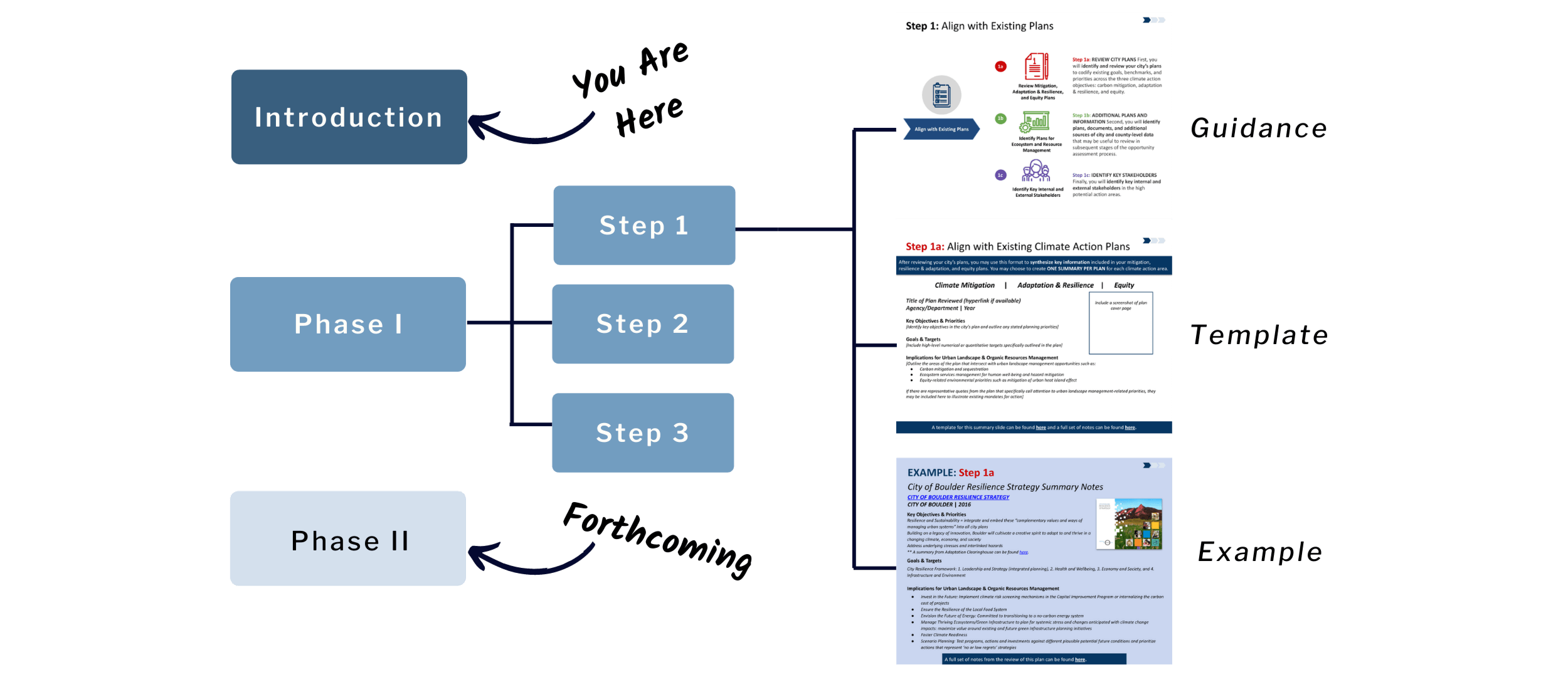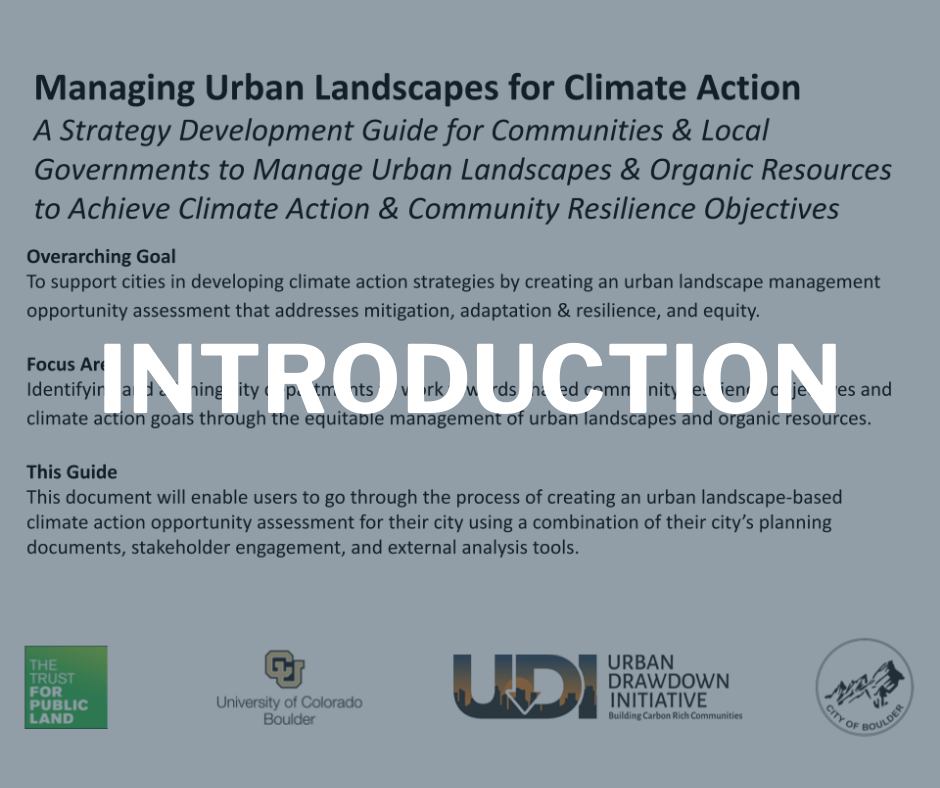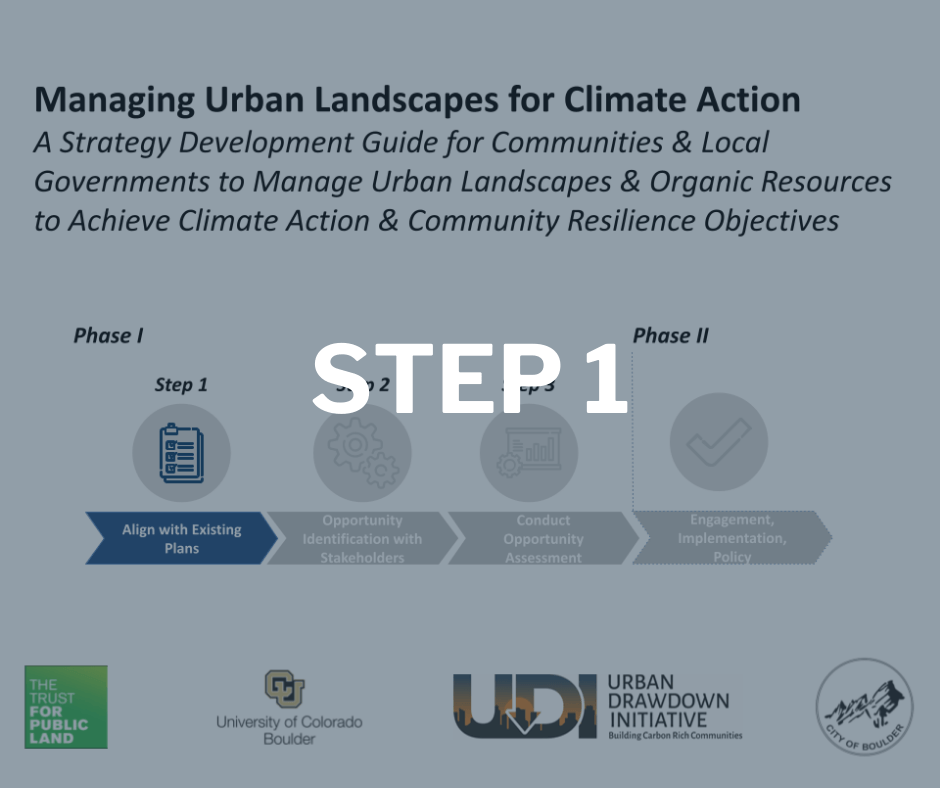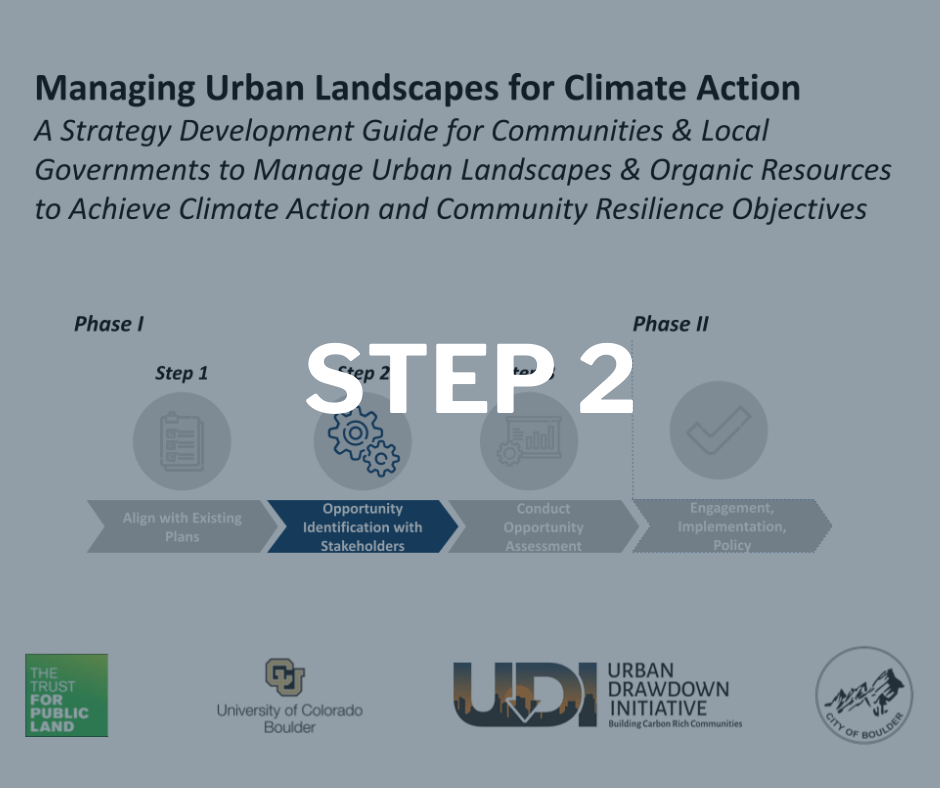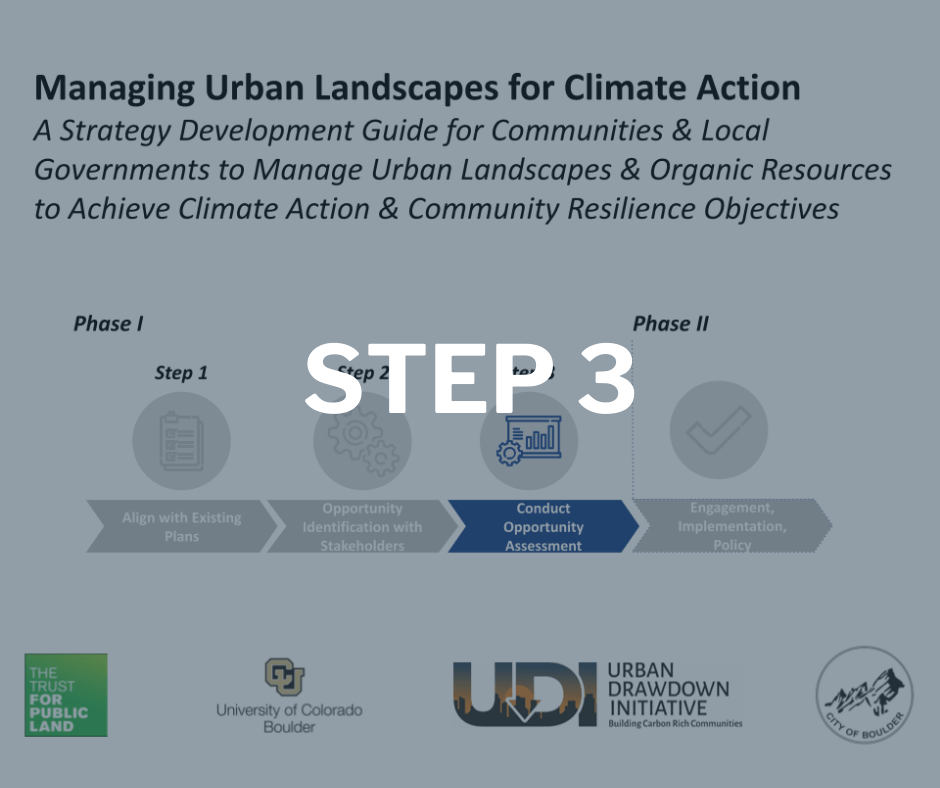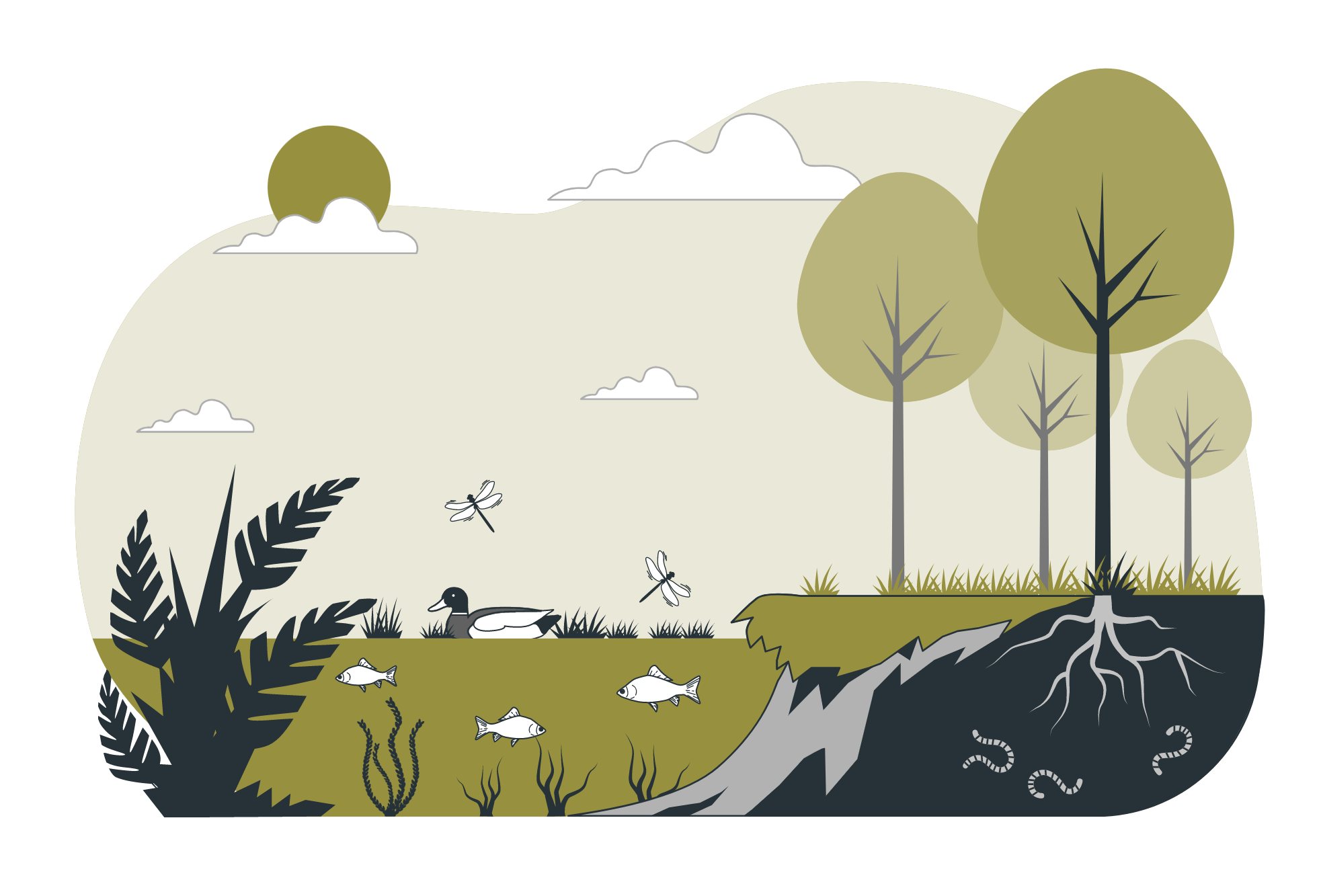
Managing Urban Landscapes
for Climate Action
A Strategy Development Guide for Communities & Local Governments to Manage Urban Landscapes & Organic Resources to Achieve Climate Action & Community Resilience Objectives
Welcome —
I am so excited to share with you the step-by-step “Managing Urban Landscapes for Climate Action” guide (a.k.a. “The Guide”). This Guide is actually a growing compendium of resources for City Planners who want to learn how to manage their urban lands for Climate Action. It is the result of an ongoing collaboration between Center for Regenerative Solutions (CRS, formerly known as the Urban Drawdown Initiative), the Urban Sustainability Directors Network’s (USDN) Natural Climate Solutions Working Group, the Trust for Public Land, and an amazing group of graduate students from the Masters for the Environment program at the University of Colorado.
The Natural Climate Solutions Working Group—comprised of planners from over 50 U.S. Cities—has been going through focused training in planning processes and analysis tools to manage urban landscapes as climate action resources—both for mitigation/adaptation and resilience/equity. This “Guide” is actually a set of resources developed throughout this training process, and we are now ready to share them—albeit still in their early stages—with anyone working at the intersection of City Planning and Climate.
There are 4 components offered below:
The Introduction to the Guide—including video presentations and a complete Table of Contents, linking to each subsequent section/resource.
The “Steps”—Broken out into 3 planning phases. Each step contains a treasure trove of additional guidance, pre-formed templates, and illustrative examples to support your local efforts.
Plans to support those using the Guide—We are excited to provide as much support as we can to communities interested in furthering this work. In fall 2021 a team of graduate students from Yale University will be picking up the work the CU team has done and providing support to a number of cities that express interest. If you are interested in accessing this type of support, please let us know.
Access to the “CRS/TPL Carbon Management Tool”—We are working to make the TPL-CRS carbon management tool available to a larger group of cities by identifying the next cohort to join the 8 who already have the tool populated with their local data (Cleveland, Lincoln, Iowa City, Columbia, San Luis Obispo, San Francisco, Fayetteville, Boulder). Let us know if you would be interested in participating in this second cohort.
On this webpage, you can continue reading to view the entirety of the Introduction online, or you can skip straight to downloading the pdf versions and reading each section in Google Slides.
We know that each community will enter this work from a slightly different place/perspective and that you will need to adapt this work to meet those conditions. We look forward to hearing from you about what is useful, what isn’t, what is missing, and what we could potentially leave out in this evolving set of tools.
I am certain there will be links that don’t work, documents you can’t seem to access, or any number of other technical gremlins that are going to jump out now that we’re releasing this guide into the world. Please let us know when they pounce on you, and be patient with us as we continue to refine this collection of resources. We look forward to continuing to evolve it with all of you for the well-being of both our communities and our beautiful planet.
— Brett KenCairn, Director of Center for Regenerative Solutions and Boulder’s Senior Policy Advisor for Climate, Sustainability & Resilience.
Managing Urban Landscapes for Climate Action
A Strategy Development Guide for Communities & Local Governments to Manage Urban Landscapes & Organic Resources to Achieve Climate Action & Community Resilience Objectives
The Overarching Goal of The Guide
To support cities in developing effective climate action strategies by creating an urban landscape management opportunity assessment that addresses mitigation, adaptation & resilience, and equity.
The Focus of The Guide
Identifying and aligning city departments to work towards shared community resilience objectives and climate action goals through the equitable management of urban landscapes and organic resources.
What This Guide Does
These resources will enable users to go through the process of creating an urban landscape-based climate action opportunity assessment for their city using a combination of their city’s planning documents, stakeholder engagement, and external analysis tools.
An Overview of the Process This Guide Will Take You Through
How To Navigate This Strategy Development Guide
You are here….
Please continue scrolling to read the full introduction and framework, and watch the introductory video presentation to the guide. Once you get to each of the Steps, you will find they each provide guidance, templates, and examples.
A Note: before beginning this work with your team, we recommend that you make yourself copies or download all of the templates of tools and tables that we have provided. The opportunity discovery process that this guide outlines relies on your use of these tools and tables.
DOWNLOAD PDFs & ACCESS GOOGLE SLIDES
Hover & click images below to access PDF & Google Slide Versions, as well as Templates.
Strategy Development Guide: Managing Urban Landscapes for Climate Action
Table of Contents
Strategy Development Guide: Managing Urban Landscapes for Climate Action
Examples and Templates
Stakeholder Engagement Materials
Annotated Bibliography and Resources
Introduction: Managing Urban Landscapes for Climate Action
Introduction — Video Presentation
The Big Picture: Core Climate Action Objectives Managing Urban Landscapes for Climate Action
The Importance of Carbon Flow in an Urban Landscape Urban Landscapes and Organic Resources — Video Presentation
Acknowledgments
Step 1: Align with Existing Plans
Step 2: Opportunity Identification
Step 3: Conduct Opportunity Assessment
Next Steps
We welcome your feedback on these resources!
Feedback
Introduction
Managing Urban Landscapes for Climate Action:
A Welcome & Orientation to the Guide by Brett KenCairn
Managing Urban Landscapes for Climate Action
A New Approach to Stabilizing Climate and Protecting Communities
A powerful and often overlooked way to pursue climate action in urban areas is by harnessing and amplifying the abilities of the living landscapes in and around cities. This both captures carbon and uses this carbon to enhance critical life support services (shade for heat management, water infiltration for stormwater management, capturing pollutants for increased air, water, & soil quality, pollinator protection for increased biodiversity etc.) This guide will provide a framework and guidance for cities to assess climate action opportunities through the lens of urban landscapes and organic resources management with respect to mitigation, adaptation & resilience, and equity.
The Big Picture: Core Climate Action Objectives
CLIMATE ACTION MUST BE GROUNDED IN THREE CORE OBJECTIVES:
Climate Mitigation
Carbon Reduction and Sequestration
Support climate stabilization by reducing emissions and sequestering carbon into stable living systems.
Carbon Sequestration
Emissions Reduction
2. Adaptation & Resilience
Change Management
Strengthen community capacity to absorb, adapt to, or transform disruptive change forces to thrive in a changing climate.
Heat Management
Reduced Drought Risk
Reduced Flood Risk
Reduced Fire Risk
Improved Air & Water Quality
Increased Biodiversity
3. Equity
Intersectional Benefits
A focus on equity-based implementation ensures that the processes for developing actions is inclusive and addresses persistent, structural race and class inequalities; as well as identifies actions that enhance equitable outcomes, such as reduced climate hazards & risks and/or increase social and economic opportunities.
Equity-Based Economic Opportunities
Equitable Distribution of Ecosystem Services
Climate Mitigation: Intersections of Urban Landscapes Management & Climate Action
Managing urban landscapes for climate action can yield significant benefits for mitigation objectives. These ecosystem service benefits are described below:
Carbon Sequestration
A process where carbon dioxide is removed from the atmosphere and used in living systems which leads to the eventual decline of carbon dioxide in the atmosphere (carbon drawdown).
Emissions Reduction
A reduction in carbon dioxide (CO2) emissions or CO2 equivalent (CO2e) emissions into the atmosphere.
Adaptation & Climate Resilience: Intersections of Urban Landscapes & Climate Action
Managing urban landscapes for climate action can yield significant benefits for adaptation and resilience objectives. These ecosystem service benefits are described below:
Heat Management
Management of temperatures, generally in the summertime, that are hotter and/or more humid than average temperatures, which can cause heat-related deaths and illnesses as well as ecosystem disruptions and die-offs.
Reduced Drought Risk
The probability of drought and the assets at risk from drought hazards.
Reduced Flood Risk
The probability of flooding and the assets at risk from flooding hazards.
Reduced Fire Risk
The probability of fire and the assets at risk from fire hazards, most likely located in the wilderness urban interface (WUI) for urban settings.
Improved Air & Water Quality
The measure of the suitability of water and air for specific purposes like ecosystem or human use (ex: drinking and breathing).
Increased Biodiversity
The variety of life in an urban ecosystem.
Equity: Intersections of Urban Landscapes & Climate Action
Managing urban landscapes for climate action can yield significant benefits for equity objectives. These ecosystem service benefits are described below:
Equity-Based Economic Opportunities
Jobs and other economic benefits such as quantified ecosystem services provided by management of the urban landscape systems.
Equitable Distribution of Ecosystem Services
Ecosystem services provided or the benefits/good provided to society from just and sustainable ecosystem management (ex: mental and physical well-being, clean water and air, biodiversity, etc.).
Building an Urban Landscape Climate Action Strategy
Why Would A City Choose to Embark on this Journey?
Core Elements:
INTEGRATION WITH EXISTING CLIMATE ACTION GOALS
Many communities have multiple climate-related plans and strategies such as emissions reductions plans, resilience & adaptation plans, and equity & social justice plans. A first step in developing an urban landscape-based climate strategy is to identify key goals across these plans that could be addressed through landscape-based climate actions.
ALIGN ACROSS DEPARTMENTS
Urban landscapes are managed by multiple agencies. A critical initial step in this process is to work with these entities to identify areas of alignment and potential partnerships across departments and communities to meet shared objectives. This may result in new and shared funding opportunities, knowledge sharing, and collaboration.
IDENTIFY AND PRIORITIZE OPPORTUNITIES
The opportunity assessment process outlined in this guide will support a multi-department/multi-stakeholder process of identifying opportunities to achieve and surpass climate action objectives across the three climate action areas (mitigation, adaptation & resilience, and equity).
With opportunities identified, the guide provides a process for conducting initial prioritization of opportunities that can then be quantified and analyzed for impact and feasibility of implementation.
QUANTIFY AND ANALYZE OPPORTUNITIES
Managing Carbon Flow in Urban Landscapes
Understanding the Role of Carbon in Urban Climate Action
CARBON AS A RESOURCE
Managing urban ecosystems and resource flows begins with the idea that carbon is a resource to be utilized in living systems to achieve climate and equity objectives. The benefits associated with sequestering carbon and managing it in urban landscapes not only lowers carbon in the atmosphere but it also serves to improve resilience to climate change impacts (e.g., heat island impacts, drought, flooding, extreme weather).
If managed strategically, captured or sequestered carbon in the form of augmented plant growth and increased soil-carbon-water cycling creates enhanced “ecosystem services” (e.g. shade for heat management, water infiltration for stormwater management, capturing pollutants for increased air, water, & soil quality, pollinator protection for increased biodiversity, etc.).
BEYOND MITIGATION:
EQUITY & SOCIAL JUSTICE
Managing urban ecosystems and resource flows can also improve social equity by directing ecosystem benefits towards vulnerable and underserved parts of urban areas. If these actions are conducted in ways that create new economic opportunities in historically underserved communities, they also help to build economic equity and social justice.
This strategy development guide outlines ways to create opportunity assessments that can serve as a starting point for bringing together and aligning carbon sequestration goals (climate mitigation), ecosystem service opportunities (adaptation & resilience), and the needs of a city’s communities (equity).
The Importance of Carbon Flows in Urban Landscapes
In this video, Dr. Jonathan Wachter reviews carbon flows in urban landscapes, highlighting a holistic approach to management for ecosystem services in terms of mitigation, adaptation & resilience, and equity.
Urban Landscapes and Organic Resources
There are 5 urban landscapes and 1 organic resource management system with high potential for ecosystem-based climate actions in or adjacent to urban areas:
Organics Management
Using a community’s organic “waste” as a resource rather than direct it to a landfill.
Urban Forests
Tree populations in urban settings which form green infrastructure.
Greenways & Riparian Areas
Management of greenways and riparian areas for habitat protection, water quality enhancement, floodplain management, recreation, and cultural resources.
Aquatic Systems
This refers to water-based systems that have significant carbon cycling and sink roles e.g. wetlands, estuaries, coastal systems.
Agricultural Systems
Urban agriculture systems like community gardens and agricultural land managed by a municipality.
Parks & Grassland (Turf)
Management of parks and open space to preserve and protect natural areas, water resources, recreation, floodplain management, and aesthetic value.
This combined framework allows us to examine the intersections of climate action and urban landscape management.
FORTHCOMING
Online Community to Support People Using This Guide
We are setting up a private online forum to support the community of people worldwide that are putting these resources into action. Join our email list or use the feedback form below to receive an invitation when we launch.
We welcome your feedback!
You can also use this form to request to be in the next cohort of cities using the UDI-TPL Carbon Management Tool, or gain access to our soon-to-launch online support community for people using this Guide.
Acknowledgements
Thank you to everyone who is contributing to this project for your work, your feedback, enthusiasm, and dedication to advancing climate action around the world. Specifically, we would like to thank:
University of Colorado Boulder, Master of the Environment Program (MENV): Ariana Borrello, Alex Giles, Maddy Nesbit, and Daniela Uribe are graduate students in the University of Colorado Boulder’s MENV program. They created this guide as part of their capstone project in partnership with the City of Boulder and the Urban Drawdown Initiative. They would like to express deep gratitude to the numerous individuals and organizations that were essential to the development of this guide. Gretel Follingstad was a continuous source of support for the MENV team as the academic advisor for this capstone project. Her ability to guide the scope of this project, review initial concepts and drafts, and provide expertise was invaluable. The following faculty, Rachel Bigby, Kimberly Kosmenko, and Lydia Lawhon, of the University of Colorado Boulder MENV program provided valuable support and constructive recommendations during the planning, research, and development of this project.
Urban Drawdown Initiative (UDI): Brett KenCairn, Senior Policy Advisor for Climate and Resilience for the City of Boulder and Director of UDI, provided immense knowledge, patience, guidance, and enthusiasm throughout this project. Brett’s dedication to transformative and effective climate action not only inspires but reminds us all why this guide is an essential tool to combating climate change.
Resource Specialists: Dr. Jonathan Wachter was a constant thought partner and generous contributor to various elements of this guide. Our team could not have conceptualized this guide without his pioneering work developing the framework for a landscape-based climate action approach and exploring the potential for such exercises across different urban contexts. He has generously allowed us to borrow extensively from his work in this project and throughout this document. Calla Rose Ostrander, Natural and Working Lands Climate Change Coordinator at California Natural Resources Agency was a key resource surrounding organic management along with her process guide.
The Trust for Public Land (TPL): Taj Schottland and Brendan Shane of TPL provided their expertise in the use and application of the UDI TPL decision support tool.
Urban Sustainability Directors Network: Finally, thank you to the many members of the Urban Sustainability Directors Network who engaged deeply with early versions of this guide and contents. Dr. Susanna Sutherland shared indispensable knowledge, insights, and resources from decades of working in urban climate and sustainability planning.








